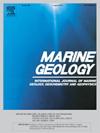人类活动强烈影响下典型潮湾系统泥沙源汇过程
IF 2.2
3区 地球科学
Q2 GEOSCIENCES, MULTIDISCIPLINARY
引用次数: 0
摘要
潮湾是海陆之间物质和能量交换强烈的区域。基于1984 - 2022年1354幅卫星影像,利用地表沉积物粒度、地球化学、水深地形等资料,采用数值模拟、水深比较法对定子湾地区沉积物输运、沉积物物源及其相对贡献进行了研究。总结了强烈人类活动下的源汇模式。鼎子湾以侵蚀为主,两岸潮滩的侵蚀和沉积存在差异,北潮滩为侵蚀,南潮滩为沉积。海湾沉积物的主要来源是北海岸的河流输沙和侵蚀。湾内南部滩涂和湾外南部滩涂是湾内为数不多的下沉区。研究区输沙路径主要为河流泥沙向湾内输沙,部分海湾泥沙随退潮向湾外输沙。北滩的侵蚀沉积物沿海岸被输送到海湾口,部分沉积物随洪流进入海湾。流域人类活动剧烈导致陆源泥沙供给减少是海湾侵蚀的主要原因,以退潮为主的潮流进一步加剧了海湾的侵蚀。本文章由计算机程序翻译,如有差异,请以英文原文为准。
Sediment source - sink processes in a typical tidal inlet bay system under intense human activities, Dingzi Bay, China
Tidal inlet bays are regions of intense material and energy exchange between the land and the sea. In this study, based on surface sediment grain size, geochemistry, bathymetric topography, and 1354 satellite images from 1984 to 2022, we used numerical modeling, bathymetric comparison methods to examine the sediment transport, sediment provenance, and relative contributions in the Dingzi Bay area. It summarizes the source-sink patterns under intense human activities. Dingzi Bay is predominantly erosive, with differences in the erosion and deposition of tidal flats on both sides of the bay, characterized by erosion on the north tidal flat and deposition on the south tidal flat. The main sources of bay sediments are river sediment transport and erosion from the north coast. The south tidal flat inside the bay and the south beach outside the bay are the few sink areas in the bay. The sediment transport path in the study area is from river sediments transported into the bay, with some bay sediments being moved out of the bay with the ebb current. Eroded sediments from the north beach are transported along the coast to the bay mouth, and some sediments are moved into the bay with the flood current. Intense human activities in the river basin leading to a reduction in terrestrial sediment supply are the main cause of bay erosion, and the ebb current-dominated tidal current further exacerbates the erosion of the bay.
求助全文
通过发布文献求助,成功后即可免费获取论文全文。
去求助
来源期刊

Marine Geology
地学-地球科学综合
CiteScore
6.10
自引率
6.90%
发文量
175
审稿时长
21.9 weeks
期刊介绍:
Marine Geology is the premier international journal on marine geological processes in the broadest sense. We seek papers that are comprehensive, interdisciplinary and synthetic that will be lasting contributions to the field. Although most papers are based on regional studies, they must demonstrate new findings of international significance. We accept papers on subjects as diverse as seafloor hydrothermal systems, beach dynamics, early diagenesis, microbiological studies in sediments, palaeoclimate studies and geophysical studies of the seabed. We encourage papers that address emerging new fields, for example the influence of anthropogenic processes on coastal/marine geology and coastal/marine geoarchaeology. We insist that the papers are concerned with the marine realm and that they deal with geology: with rocks, sediments, and physical and chemical processes affecting them. Papers should address scientific hypotheses: highly descriptive data compilations or papers that deal only with marine management and risk assessment should be submitted to other journals. Papers on laboratory or modelling studies must demonstrate direct relevance to marine processes or deposits. The primary criteria for acceptance of papers is that the science is of high quality, novel, significant, and of broad international interest.
 求助内容:
求助内容: 应助结果提醒方式:
应助结果提醒方式:


